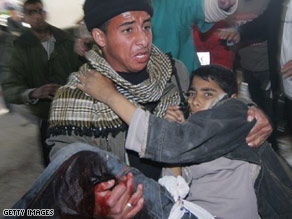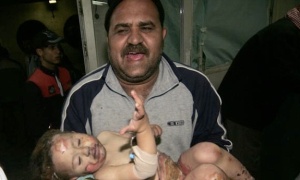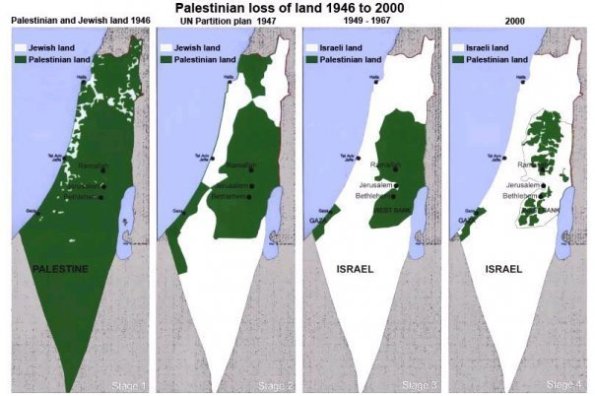Archive
AUC ‘MAKES HISTORY AGAIN,’ INAUGURATES NEW CAIRO CAMPUS
By: Safa Abdoun.. February 8, 2009
CAIRO: After a decade of planning and five years of construction, in a grand celebration which marks a new era in the American University in Cairo’s history, Egypt’s First Lady Suzanne Mubarak officially inaugurated the university’s new campus in the presence of Egyptian and international dignitaries and key public figures.
“It is a delight to celebrate this historical occasion…after my tour, one word that would describe this campus is that it is ‘awesome’,” said Mubarak, who has received both her bachelor’s degree and master’s degree from AUC.
“In these difficult times, I must say that this campus is a foundation for a better future as it provides an atmosphere of hope and achievement,” added Mubarak.
Mubarak also attended campus’ groundbreaking ceremony in 2003 and laid the first cornerstone showing her support to AUC.
“At the present, AUC has over 30,000 alumni since 1923 which have become leaders and innovators in every field around the world; scientists, philanthropists, engineers and occasionally a First Lady here and there,” she joked.
AUC President David Arnold described Mubarak as an embodiment of “the commitment to community service which we strive to build in our students.”
Mubarak hailed late AUC President John D. Gerhart and his commitment to building this campus. “I’m certain he will be proud [and I’m glad] his wife and daughter are here to witness the fulfillment of his dream,” she said.
The First Lady spoke of AUC’s history and how it produced “outstanding students,” noting that over half of them are females and 20 percent are foreigners. She also lauded the university’s role in fostering cultural and religious understanding through its promotion of international and regional dialogue.
“As an alumni, a mother of an alumni and recently a mother-in-law, I find great pride in AUC students and alumni not only their academics but in their fulfillment of civic responsibility,” she said.
“Finally, with important facilities and the efforts of its stakeholders, AUC will continue to live up to our expectations and have an impact on Egypt, the region and the world,” Mubarak said.
Also present at the inauguration was United States’ Ambassador to Egypt, Margaret Scobey, being “a steadfast supporter and continuing to hold a strong friendship [with AUC] as her predecessors,” Arnold said.
Scobey described AUC as a vital bridge between East and West, and how it has more US students than any other university in the region.
“The US government through the UNAIDS has donated $270 million for AUC over the years in order to set pace for continued growth of the institution and make it more accessible for people throughout Egypt,” said Scobey, citing scholarship programs such as the Leadership for Education and Development (LEAD) which 270 students have benefited from.
The highlight of Scobey’s speech was a message from US President, Barack Hussein Obama, who she noted once said that “the only reason I am where I am today is because this country that I love gave me the chance at an education.”
Obama talked of AUC as a US-Egyptian partnership where for the past 90 years Egyptians and Americans have studied and researched together getting a unique educational experience.
“[This is a] science of understanding that will improve all of our lives,” he said.
Another speaker was B. Boyd Hight, chairman of AUC’s Board of Trustees, who explained how AUC was initially “a dream of a few Americans a century ago to have an American style education in Egypt so that its students would provide a better future for themselves, their families and their country.”
“The Tahrir campus was temporary and their plan was to build a campus outside the city and today, 90 years later, we celebrate the execution of this plan,” he said.
Hight said they were first torn between the unique location at the center of the city and not having enough space to accommodate the facilities, which prompted the idea of the new campus.
He recognized the government’s role of helping them find this 260-acre land. “After we had the site, there was the challenge of raising the money,” said Hight adding that tuition revenues are never sufficient to cover a $400 million campus.
“People donated with the belief that nothing is more important to developing society than the education of its leaders…Gerhart, Arnold and [Moataz] El Alfi were able to raise $130 million from private gifts and contributions, and the UNAIDS donated LE 600 million, which is quarter the cost of the campus,” he explained.
Five different architectural firms from the US, Mexico and Egypt worked on designing and building the new campus, in what Gerhart described as “international teams, designing an international university for an international city.”
The campus is designed to include an academic center, which includes the university’s 400,000 volume library and all the facilities for teaching, research and intellectual interaction; a campus center for all aspects of non-academic student life and also for conferences and public lectures; a residential housing for non-commuting Egyptian and international students; spacious indoor and outdoor athletic and ports facilities and a public bookstore.
“AUC has been an important part of the Egyptian educational, social and cultural scene for the past 90 years,” said Arnold. “Through our new campus we are becoming an outstanding educational institution with unrivaled facilities, which will benefit not only Egypt but the entire region,” he added.
In celebration of its official inauguration, AUC is holding a weeklong series of events, including cultural and academic panels featuring prominent speakers and intellectuals from around the world.
source: http://www.thedailynewsegypt.com/article.aspx?ArticleID=19620
GAZA…
What’s Happening in GAZA…Does it worth ???
 Sunday: Ground invasionIsraeli military operations continued into their ninth day on Sunday with a ground war in northern Gaza. Israeli forces moved across Gaza fromKarni Crossing to Beach Road, closing all roads and splitting the region in two. There were Palestinian reports of fighting outside the former Netzarim and south of Gaza City. According to Palestinian reports, Israeli troops had surrounded Beit Hanounand were in the outskirts of Beit Lahiyaand Jabaliya refugee camp. The American International Schoolwas almost completely destroyed; up to five other schools were damaged by Israeli shelling of nearby targets. In Gaza City, at least five civilians were killed and many more wounded after Israeli rockets or shells landed in the market. Wounded civilians poured into Shifa Hospital, including some women and children. Hamas continued rocket fire, launching up to 25 rockets into southern Israel by Sunday afternoon, including the Israeli border town of Sderot, wounding at least three Israelis
Sunday: Ground invasionIsraeli military operations continued into their ninth day on Sunday with a ground war in northern Gaza. Israeli forces moved across Gaza fromKarni Crossing to Beach Road, closing all roads and splitting the region in two. There were Palestinian reports of fighting outside the former Netzarim and south of Gaza City. According to Palestinian reports, Israeli troops had surrounded Beit Hanounand were in the outskirts of Beit Lahiyaand Jabaliya refugee camp. The American International Schoolwas almost completely destroyed; up to five other schools were damaged by Israeli shelling of nearby targets. In Gaza City, at least five civilians were killed and many more wounded after Israeli rockets or shells landed in the market. Wounded civilians poured into Shifa Hospital, including some women and children. Hamas continued rocket fire, launching up to 25 rockets into southern Israel by Sunday afternoon, including the Israeli border town of Sderot, wounding at least three Israelis









Iraqi journalist throws shoes at Bush in Baghdad
BAGHDAD, Iraq (CNN) — A man identified as an Iraqi journalist threw shoes at — but missed — President Bush during a news conference Sunday evening in Baghdad, where Bush was making a farewell visit.

Bush ducked, and the shoes, flung one at a time, sailed past his head during the news conference with Prime Minister Nuri al-Maliki in his palace in the heavily fortified Green Zone.
The shoe-thrower — identified as Muntadhar al-Zaidi, an Iraqi journalist with Egypt-based al-Baghdadia television network — could be heard yelling in Arabic: “This is a farewell … you dog!”
While pinned on the ground by security personnel, he screamed: “You killed the Iraqis!”
Al-Zaidi was dragged away. While al-Zaidi was still screaming in another room, Bush said: “That was a size 10 shoe he threw at me, you may want to know.”
Hurling shoes at someone, or sitting so that the bottom of a shoe faces another person, is considered an insult among Muslims.
Al-Baghdadia issued a statement Sunday demanding al-Zaidi’s release.
Al-Zaidi remained in custody Monday while the Iraqi judiciary decides whether he will face charges of assaulting al-Maliki, a government official said.
The official said al-Zaidi is being tested for alcohol and drugs to determine if he was fully conscious during the incident.
Al-Zaidi drew international attention in November 2007 when he was kidnapped while on his way to work in central Baghdad. He was released three days later.
Bush had been lauding the conclusion of a security pact with Iraq as journalists looked on.
“So what if the guy threw his shoe at me?” Bush told a reporter in response to a question about the incident.
“Let me talk about the guy throwing his shoe. It’s one way to gain attention. It’s like going to a political rally and having people yell at you. It’s like driving down the street and having people not gesturing with all five fingers. …
“These journalists here were very apologetic. They … said this doesn’t represent the Iraqi people, but that’s what happens in free societies where people try to draw attention to themselves.”
Bush then directed his comments to the security pact, which he and al-Maliki were preparing to sign, hailing it as “a major achievement” but cautioning that “there is more work to be done.”
The visit was Bush’s fourth since the U.S.-led invasion of Iraq in March 2003……………
